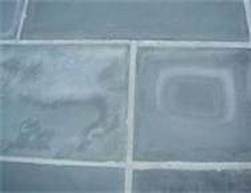
And one thing that has come up on more than a few of these installations is the presence of leaching.
No, I’m not talking about the little blood-sucking worms, thank goodness (I really don't want to get labeled as the blood-sucking parasite blogger, although this is two weeks in a row the word "parasite" has come up). No, I’m talking about efflorescence. And it’s not necessarily a bad thing, but in some cases it may require a bit of patience.
Leaching, or efflorescence as it also referred to, is simply the extraction of water-soluble salts from inside the masonry. Here’s how it happens.
Lets say you just had a new wet-set flagstone patio installed. There’s the gravel sub-base, the concrete footing, the bed of mortar, and the visible stones on the surface. Each of those layers contains various types of salts. And as the concrete and mortar dry and cure, those materials need to extract the salts.
So your contractor has finished the project and completed the final washdown. You’re thrilled with your new outdoor living space, pay your contractor and begin to enjoy your patio. But after a few weeks and perhaps a few rainstorms you begin to notice a few whitish stains on the surface. At first you think nothing of it, but after a few more weeks you notice more stains. Maybe you call your contractor back and ask for another wash-down to remove the stains. And maybe he does. And then, a few weeks later … it’s baaaaack. More white stains a few weeks later. What the heck is going on!?
What is happening is that as the concrete and mortar dries, its tendency is to want to suck up more moisture from the sub-base. This moisture slowly works its way through the surface stones and joints and evaporates. But what’s left behind is the deposits of salt from the groundwater and inside the masonry. Now plainly visible and messing up your beautiful stonework.
So should you be concerned?
Simple answer – no.
Typically the leaching cycle lasts no more than a month or two on new hardscape installs. Once the supply of salts from within the masonry is exhausted, the process is complete and you have nothing more to worry about. In extreme cases, I have heard of the leaching cycle lasting as long as a year or two, depending on how much salt may be in the natural existing soil. But personally I’ve never seen any leaching lasting this long, but if you’re in an area with particularly salty soil you might want to prepare yourself for this. I’ve also seen it occurring from behind retaining walls, again if the native soil has a high salt content.
But the good news is that there is no compromising of the integrity of the masonry. I’ve seen it happen mostly with wet-set flagstone and brick, but in a few cases I’ve even seen it happen in dryset paver installations. After all, those pavers are made from concrete, and may still have a few salts to extract upon arrival from the manufacturer.
If the efflorescence is particularly unsightly, or you absolutely can’t wait for the process to work itself out on its own, there are a number of products designed specifically to remove the efflorescence. These products are typically acid-based products designed to neutralize the salts and remove them. These products can vary slightly from each manufacturer, so be sure to ask your hardscaping supplier which products they carry and the appropriate application instructions.
One last word, many clients and homeowners may be interested in sealing that new patio or walkway to protect the hardscaping and perhaps even give it more of a glazed finish. While sealing certainly isn’t going to hurt the hardscaping, I always recommend waiting at least a month or two before applying the sealer. This will allow ample opportunity for the salts to work themselves out and wash away, without being trapped under the sealant.
Now stay tuned for next week's post on parasitic hookworms. (Just joking -- I'll try and stay away from the parasite references for at least a few more weeks!)




 RSS Feed
RSS Feed